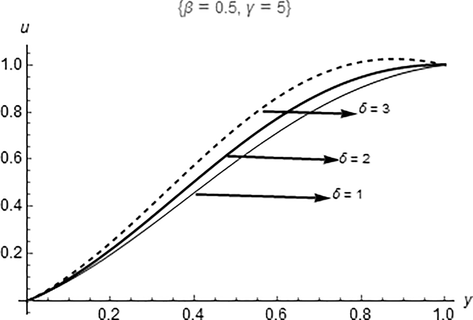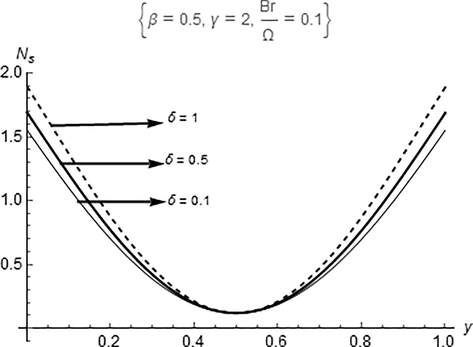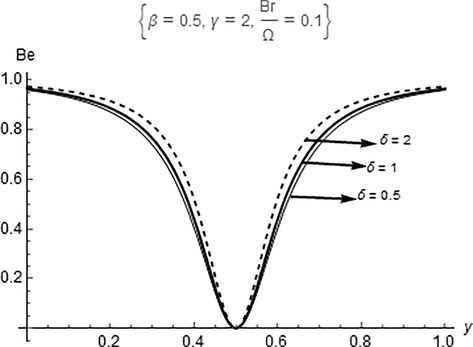Thermodynamics analysis of an internal heat generating fluid of a variable viscosity reactive couette flow
-
Received: ,
Accepted: ,
This article was originally published by Elsevier and was migrated to Scientific Scholar after the change of Publisher.
Peer review under responsibility of King Saud University.
Abstract
The present investigation examined the influence of heat source on a variable viscosity reactive Couette fluid flow. The upper plate moves with constant velocity while the lower plate is kept fixed. The heat source is considered to be a linear function of temperature while the fluid viscosity depends on temperature. The coupled set of differential equations regulating the fluid regime are obtained using the technique of Adomian Decomposition Method (ADM). Graphical and tabular representations showed the impacts of heat source parameter by increasing the fluid motion and temperature. Finally, the outcome of the solutions compared with previously obtained results without the influence of internal energy parameter significantly showed the effects.
Keywords
Reactive fluids
Couette flow
Internal heat generation
Adomian Decomposition Method (ADM)
1 Introduction
Many investigative studies like in Akhtar et al. (2008) explained that fluid behaves uniquely under different circumstances. Recently, appreciable awareness has been given to the analysis of variable viscosity reactive fluid flow due to its significance in many industrial and engineering applications, especially in fluid machinery involving moving parts where hydromagnetic lubrication is in use as mentioned in Kobo and Makinde (2010). The study in Hassan and Gbadeyan (2015) further ascertained the importance of taking precautions of a reacting material undergoing an exothermic reaction where heat is being produce in accordance with chemical reaction. Many studies have been conducted on the impact of heat source on various types of fluid moving under different situations, extensively in Patil and Kulkarni (2008), Jha and Ajibade (2009), Perekattu and Balaji (2009), Chen (2010), El-Amin (2004), Bagai and Nishad (2012), Oztop and Bilgen (2006), Ben-Nakhi and Chamkha (2007), D̃i Marcello et al. (2010), Cortell (2005), Jawdat and Hashim (2010), Bartella and Nield (2012) and Hayat et al. (2015) investigated so much on the significance of internally generated heat caused within fluid flow due to interaction between the surfaces, porosity, chemical reactions, thermal boundary conditions, temperature and pressure gradients, to mention few.
However, the importance of this study is on how to utilize heat generation or absorption in different fluids moving within channels which has been a major concern to many researchers because of its necessity in industrial and engineering applications to avoid hazards and also to increase productivity. Notably, Hassan and Gbadeyan, 2015 did not consider the impact of the heat source, but noted that the consequence of hydromagnetic reactive flows that are commonly associated with heat generation cannot be totally neglected. Other recent significant studies involving the internal heat generation can be found in Hassan and Gbadeyan (2015), Hassan and Maritz (2016), Hassan and Maritz (2016) and Hassan and Maritz (2017).
The present study is motivated to examine the impact of internal heat source on a variable viscosity reactive Couette fluid flow which was done in Kobo and Makinde, 2010 by neglecting the influence of internal heat source. The velocities at the upper (in motion) and lower plates of the channel are respectively constant and stationary. The internal heat generation is a linear function of temperature while the fluid viscosity is temperature dependent. The analytical solutions of the coupled sets of differential equations regulating the fluid flow are secured by applying the technique of Adomian Decomposition Method (ADM) with suitable estimation by comparing with previously obtained results in literature to show the significance. The choice of this method is due to the fact that the method does not require any use of guess value but reliable and a better alternative way in providing solutions to differential and integral equations in rapidly convergent series. Few studies to show the effectiveness of ADM with other methods are found in Gul et al. (2015), Gul et al. (2016), Hassan and Gbadeyan (2015), Gbadeyan and Hassan (2012), Wazwaz and El-Sayed (2001), Hassan and Fenuga (2011), Ghani et al. (2016) and Gul et al. (2014).
The plan of the present study formulates the problem in Section 2. In Section 3, the solutions to coupled set of equations are obtained with the use of ADM and the expressions are used to present tables and graphs in Section 4 while the concluding remark is presented in Section 5.
2 Problem Formulation
The below figure (Fig. 1) shows the configuration of the fluid under consideration.The fluid is viscous, incompressible, reactive and steady in the x-direction between two plates that are parallel with width, H and length, L. For Couette flow, the upper plate in motion moves with constant velocity while the lower plate is kept fixed.

- Geometry of the Problem.
The temperature dependent viscosity
By disregarding the utilization of the reactant to its minimum, the velocity and energy equations regulating the flow in dimensional form is given as:
The velocity scale is represented with
Therefore, using (6), the dimensionless forms of Eqs. (2)–(5) becomes:
Integrating (7) with the boundary conditions, we obtain
Substituting (11) into (8), we obtain
3 Method of solution
The governing Eqs. (11) and (12) with the boundary conditions (10) are obtained using the ADM technique. Literature is rich for this method in Gul et al. (2015), Gul et al. (2016), Hassan and Gbadeyan (2015), Gbadeyan and Hassan (2012), Wazwaz and El-Sayed (2001), Hassan and Fenuga (2011) and Ghani et al. (2016). The results from this method has been shown to be an alternative and reliable approximations that converge very rapidly. It is necessary for convenience to commence with the solution of (12) using the series solution (ADM). Therefore, we respectively integrate (12) and (11) twice and once to give the followings:
However, the entropy generation rate from (9) can be described to be the rate of disturbance created from the interaction of the fluid flow within both upper and lower plates. From Hassan and Gbadeyan (2015), Makinde and Maserumule (2008) and Wood (1975), the irreversibility ratio denoted by Bejan
Also, the skin friction
4 Discussion of results
The tabular and graphical representations of the impact of heat source on a variable viscosity Couette reactive fluid flow and other important flow parameters are presented and discussed. The choice of values for each parameter is in agreement with Kobo and Makinde (2010) and Makinde and Maserumule (2008) in order to significantly show the effect of internal heat energy produced within the flow regime.
Table 1 shows the computation of rapid convergence of the series solutions (ADM) with few iterations and gives approximate values for the constants
|
|
||
|---|---|---|
| n |
|
|
| 0 |
|
0 |
| 1 |
|
|
| 2 |
|
|
| 3 |
|
|
| 4 |
|
|
| 5 |
|
|
| 6 |
|
|
| 7 |
|
|
Table 2 shows the comparison between Adomian Decomposition Method (ADM) and results of Kobo and Makinde, 2010 where perturbation (PM) and numerical method (NM) were used. The numerical results of both methods were compared by setting the internal heat generation parameter to be zero, that is,
|
|
||||||
|---|---|---|---|---|---|---|
| y |
|
|
|
|
|
|
| 0 |
|
0 |
|
0 |
|
0 |
|
|
|
|
|
|
|
|
|
|
|
|
|
|
|
|
|
|
|
|
|
|
|
|
|
|
|
|
|
|
|
|
|
|
|
|
|
|
|
|
|
|
|
|
|
|
|
|
|
|
|
|
|
|
|
|
|
|
|
|
|
|
|
|
|
|
|
|
|
|
|
|
| 1 |
|
0 |
|
0 |
|
0 |
Also, Table 3 shows the computation of Nusselt numbers and skin friction for variation in the values of (
|
|
|
|
|
|
|---|---|---|---|---|
|
|
|
|
|
|
|
|
|
|
|
|
|
|
|
|
|
|
|
|
|
|
|
|
|
|
|
|
|
|
|
|
|
|
|
|
The impact of heat source parameter (

- Impact of

- Impact of
The entropy generation rate in the flow regime with respect to the impact of heat source parameter (

- Effect of

- Effect of
5 Conclusion
The influence of internal heat source on a variable viscosity reactive Couette fluid flow was investigated. The results were compared with Kobo and Makinde, 2010 where the effect of heat source was not accounted for. It is assumed that the lower plate is fixed while the upper plate moves with a constant velocity. The coupled nonlinear dimensionless differential equations regulating the fluid flow are determined by employing the technique of Adomian Decomposition Method (ADM). The result from ADM and previously obtained results from Kobo and Makinde, 2010 showed evidently that they are almost identical with a general difference of order
References
- Flow of maxwell fluid between two sides wall induced by a constantly accelerating plates. Int. J. Z. Angew, Math. Phys. 2008 1007/S00033008-7129-8
- [Google Scholar]
- Free convection in a non-newtonian fluid along a horizontal plate embedded in a porous media with internal heat generation. Int. Commun. Heat Mass Transfer. 2012;39:537-540.
- [Google Scholar]
- On the rayleigh-bernard poiseuille problem with internal heat generation. Int. J. Therm. Sci. Heat Mass Transf.. 2012;57:1-16.
- [Google Scholar]
- Conjugate natural convection around a finned pipe in a square enclose with internal heat generation. Int. J. Heat Mass Transf.. 2007;50:2260-2271.
- [Google Scholar]
- On analytic solution of mhd flow and heat transfer for two types of viscoelastic fluid over a stretching sheet with energy dissipation, internal heat source and thermal radiation. Int. J. Heat Mass Transf.. 2010;53:4264-4273.
- [Google Scholar]
- Flow and heat transfer of a fluid through a porous medium over a stretching surface with internal heat generation/absorption and suction/blowing. Fluid Dyn. Res.. 2005;37:231-245.
- [Google Scholar]
- A generalized approach to heat transfer in pipe flow with internal heat generation. Chem. Eng. Sci.. 2010;65:1301-1310.
- [Google Scholar]
- Combined effect of internal heat generation and magnetic field on free convection and mass transfer flow in a micro polar fluid with constant suction. J. Magn. Magn. Mater.. 2004;270:130-135.
- [Google Scholar]
- Multiplicity of solutions for a reactive variable viscous couette flow under arrhenius kinetics. Math. Theory Model.. 2012;2(9):39-49.
- [Google Scholar]
- Unsteady magnetohydrodynamics thin film flow of a third grade fluid over an oscillating inclined belt embedded in a porous medium. Therm. Sci.. 2016;5:875-887.
- [Google Scholar]
- Thin film flow in mhd third grade fluid on a vertical belt with temperature dependent viscosity. PloS One. 2014;9(6):e97552.
- [Google Scholar]
- Unsteady mhd thin film flow of an oldroyd-b fluid over an oscillating inclined belt. PloS One. 2015;10(7):e0126698.
- [Google Scholar]
- Unsteady thin film flow of a fourth grade fluid over a vertical moving and oscillating belt. Propul. Power Res.. 2016;5(3):223-235.
- [Google Scholar]
- Flow of a maxwell fluid through a porous medium induced by a constantly accelerating plate. J. Nigerian Assoc. Math. Phys.. 2011;19:249-254.
- [Google Scholar]
- A reactive hydromagnetic internal heat generating fluid flow through a channel. Int. J. Heat Technol.. 2015;33(3):43-50.
- [Google Scholar]
- Entropy generation analysis of a reactive hydromagnetic fluid flow through a channel. U. P. B. Sci. Bull. Series A. 2015;77(2):285-296.
- [Google Scholar]
- The analysis of a reactive hydromagnetic internal heat generating poiseuille fluid flow through a channel. SpringerPlus. 2016;5(1):1-14.
- [Google Scholar]
- The analysis of a variable-viscosity fluid flow between parallel porous plates with non-uniform wall temperature. Italian J. Pure Appl. Math.. 2016;36:1-12.
- [Google Scholar]
- The effect of internal heat generation on a steady hydromagnetic poiseuille fluid flow between two parallel porous plates. Kragujevac J. Sci. 2017;39:37-46.
- [Google Scholar]
- Convective heat and mass transfer effects in three-dimensional flow of maxwell fluid over a stretching surface with heat source. J. Central South Univ.. 2015;22(2):717-726.
- [Google Scholar]
- Low prandtl number chaotic convection in porous media with uniform internal heat generation. Int. Commun. Heat Mass Transf.. 2010;37:629-636.
- [Google Scholar]
- Free convective flow of heat generating/absorbing fluid between vertical porous plates with periodic heat input. J. Int. Commun. Heat Mass Transf.. 2009;36:624-631.
- [Google Scholar]
- Second law analysis for a variable viscosity reactive couette flow under arhenius kinetics. Math. Prob. Eng.. 2010;1–15:2010.
- [Google Scholar]
- Thermal criticality and entropy analysis for a variable viscosity couette flow. Phys. Scr.. 2008;78:1-6.
- [Google Scholar]
- Natural convection in differentially heated and partially divided square cavities with internal heat generation. Int. J. Heat Fluid Flow. 2006;27:466-475.
- [Google Scholar]
- Effects of chemical reaction on free convective flow of a polar fluid through porous medium in the presence of internal heat generation. Int. J. Therm. Sci.. 2008;7:1043-1054.
- [Google Scholar]
- On the onset of natural convection in differentially heated shallow fluid layers with internal heat generation. Int. J. Heat Mass Transf.. 2009;52:4254-4263.
- [Google Scholar]
- A new modification of the adomian decomposition method for linear and nonlinear operators. Appl. Maths Comput.. 2001;122:393-405.
- [Google Scholar]
- Thermodynamics of Fluid Systems. Oxford: Oxford University Press; 1975.







